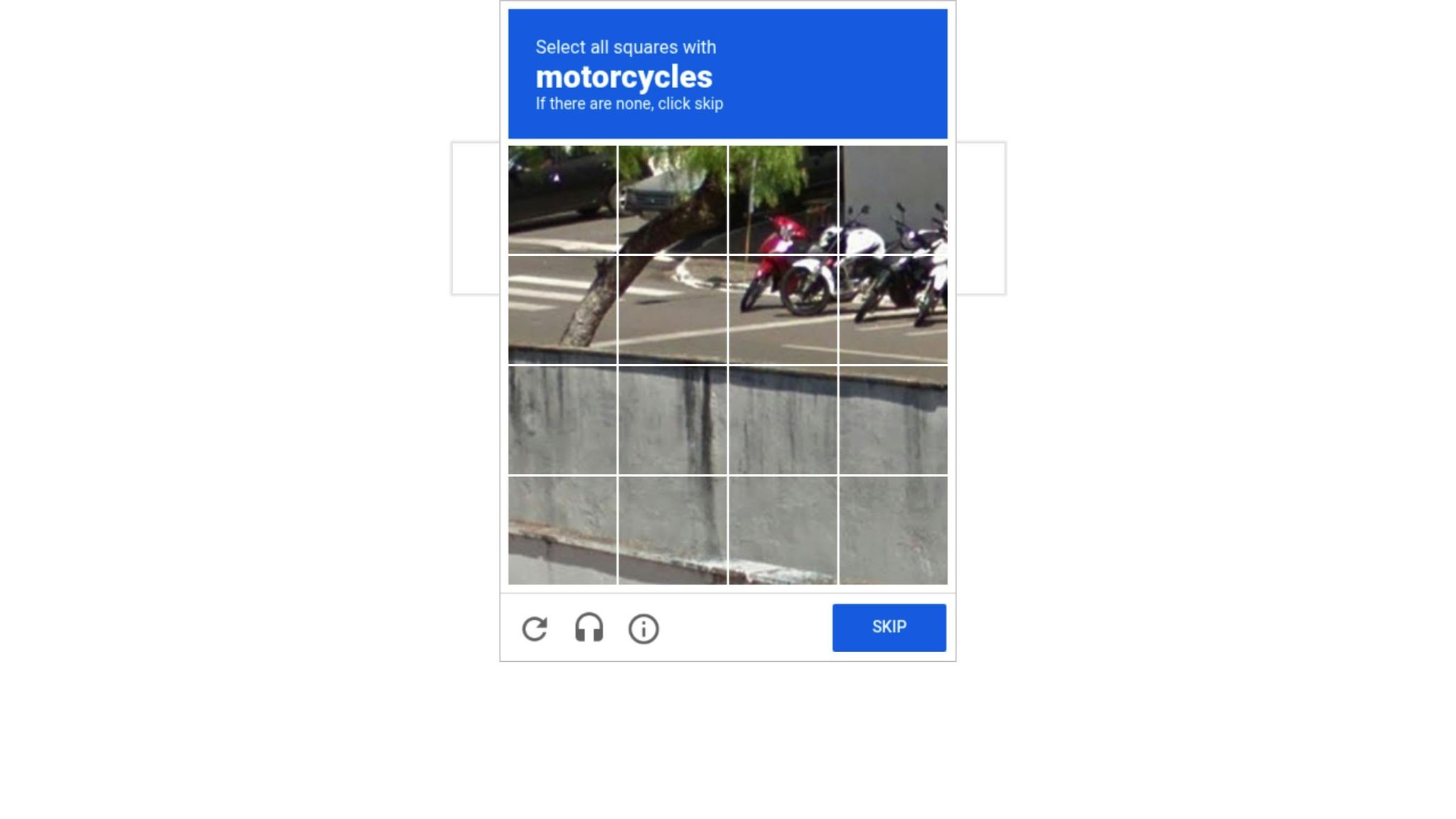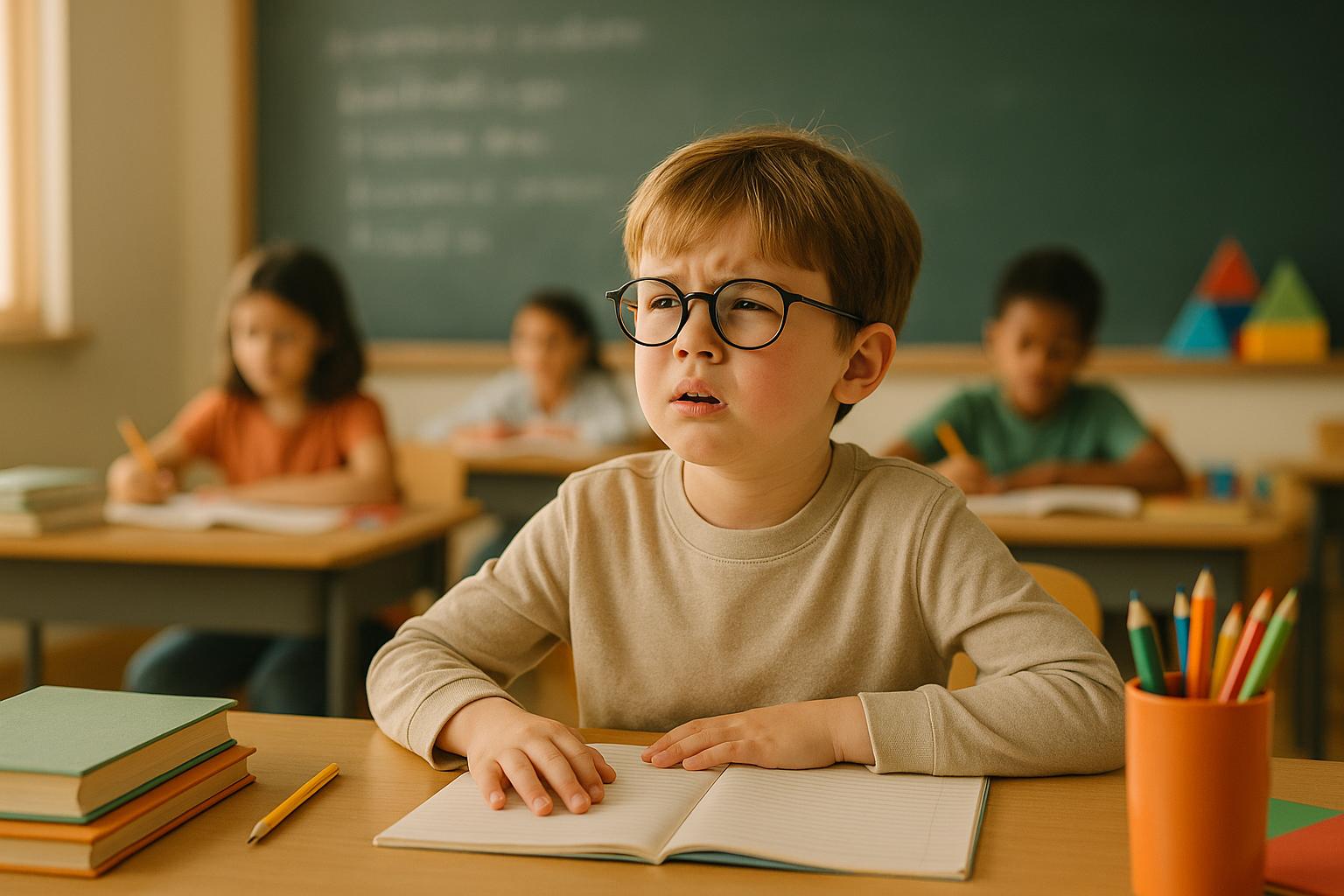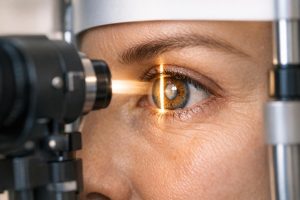Did you know that 1 in 4 school-aged kids may have vision issues impacting their learning? Yet, only a small percentage are diagnosed. Vision problems can lead to struggles in school, headaches, and even social challenges. Early detection is key to helping children succeed academically and socially.
Key Signs to Watch For:
- Physical symptoms: Squinting, frequent eye rubbing, redness, or misaligned eyes.
- Behavioral changes: Avoiding reading, holding objects too close, or frequent headaches.
- School struggles: Losing place while reading, slow homework completion, or frustration with visual tasks.
Regular eye exams are critical, even if no symptoms are obvious. Experts recommend exams at 6 months, age 3, and before starting school, with follow-ups every 1–2 years. Acting early can prevent long-term complications and improve a child’s quality of life.
8 Subtle Signs Your Child Might Need Glasses | Pediatric Ophthalmologist Explains
Common Signs of Vision Problems in Children
Spotting vision problems in children can be tricky since they often can’t explain what they’re experiencing. This means parents and caregivers need to stay alert for both physical symptoms and behavioral changes that might indicate trouble with their eyesight.
Physical Symptoms
Some of the most noticeable signs of vision issues show up as physical symptoms. For instance:
- Squinting: A child might squint to try to focus better, which could point to refractive errors like nearsightedness (trouble seeing far away) or farsightedness (trouble seeing up close).
- Frequent eye rubbing: This can signal eye strain or fatigue.
- Abnormal eye alignment or appearance: If your child’s eyes appear crossed, misaligned, or don’t move in sync, it could indicate alignment problems. Keep an eye out for other unusual signs like a white or grayish hue in the pupil, bulging eyes, or rapid, fluttering eye movements – all of which require immediate attention.
- Redness and irritation: Persistent redness, swollen or crusted eyelids, or excessive discharge might mean there’s an infection or inflammation.
- Drooping eyelids or light sensitivity: Drooping eyelids could point to neurological or muscular concerns, while sensitivity to light or watery eyes may also signal underlying issues.
While these physical symptoms are often easy to spot, a child’s behavior can also reveal hidden vision problems.
Behavioral Indicators
Behavioral changes can be just as telling as physical symptoms. Children may unconsciously adjust their actions to cope with poor vision. For example:
- Holding objects close: If your child frequently holds books or toys very close to their face, it could indicate farsightedness.
- Unusual head movements: Tilting their head, covering one eye, or adjusting their head position to focus better can suggest refractive errors or mild eye misalignment.
- Avoiding certain activities: Kids struggling with vision problems might shy away from tasks that require focus, like reading or drawing. They may also lose interest quickly, lose their place while reading, or become irritable during close-up work. Excessive blinking while trying to focus is another red flag.
- Complaints about vision: Phrases like "I can’t see clearly" or "Everything looks blurry" shouldn’t be ignored. Additionally, watch for signs of discomfort, dizziness, or headaches during visual tasks.
It’s worth noting that many children won’t express their vision troubles – either because they don’t know their experience is different from others or lack the words to explain it.
Catching these signs early can lead to quicker evaluations by an expert, paving the way for better outcomes and healthier vision.
School and Daily Activity Warning Signs
Sometimes, a child’s vision problems aren’t immediately obvious through physical signs alone. Instead, struggles with schoolwork and daily activities can offer subtle clues. These challenges often highlight the importance of addressing potential vision issues promptly.
Problems with Schoolwork
Reading troubles can be one of the clearest indicators of vision problems in children. A child who has difficulty seeing clearly might lose their place while reading, skip words, or hold books unusually close to their face. You might also notice them taking an unusually long time to finish homework or needing to reread passages over and over.
Unaddressed vision problems can lead to a noticeable drop in academic performance. Children might struggle to recognize familiar words, make frequent errors on their assignments, or become frustrated to the point of avoiding homework altogether. Teachers may observe that these students appear distracted during lessons or have trouble staying focused, particularly during reading activities.
Unfortunately, many vision problems go undetected, causing unnecessary challenges in the classroom – challenges that could often be resolved with the right treatment.
Avoiding Visual Activities
Avoidance of certain tasks can also signal vision problems. Kids often develop coping mechanisms to steer clear of activities that cause discomfort. For example, a child might shy away from reading time, avoid drawing or coloring, or complain of tired or sore eyes after working on visual tasks.
This avoidance isn’t limited to schoolwork. Kids may also steer clear of visually demanding activities during playtime, expressing frustration or boredom with tasks their peers enjoy.
Dr. Misty Watters, O.D., explains that children often don’t realize their struggles are vision-related. Instead, they may simply avoid tasks that feel challenging or uncomfortable.
Sometimes, these vision-related difficulties are mistaken for learning or behavioral issues. This can lead to unfair labels, such as being unmotivated or having attention problems, when the core issue is a vision problem.
Headaches and Tiredness
Frequent headaches, especially after reading or using a computer, can also point to vision issues. Tiredness or eye fatigue often accompanies these headaches, worsening as the day goes on. In some cases, children may even experience dizziness or nausea after extended periods of close-up work.
If your child frequently complains of headaches after doing homework or seems unusually tired after school, it could be because their eyes are straining to compensate for an underlying issue. Over time, this excessive focusing leads to discomfort and fatigue.
For instance, one student’s reading and concentration improved significantly after corrective lenses resolved their recurring headaches.
Addressing these symptoms early can help prevent more significant academic and social challenges. If you notice persistent signs like frequent headaches, avoidance of visual tasks, or declining performance in school, it’s time to schedule an eye exam. Specialists such as Boulder Eye Surgeons provide expert pediatric eye care, offering advanced diagnostics and customized treatment plans for children in Boulder, CO, and nearby areas.
sbb-itb-c87b093
When to Schedule an Eye Exam
Regular eye exams are essential for spotting both gradual and sudden vision issues before they lead to long-term complications. Below, we’ll highlight the key warning signs that call for immediate attention.
Red Flag Symptoms
Some symptoms signal the need for immediate care and shouldn’t be postponed until a routine checkup. For instance, misaligned eyes – whether crossed, turned inward, or outward – require prompt evaluation, as the condition can worsen without timely treatment.
Abnormal pupil appearance, such as white or cloudy pupils, is another serious sign that demands an urgent exam.
Persistent eye pain, redness, swelling, or discharge should also be addressed right away.
Sudden changes in vision – like double vision, ongoing blurriness, or vision loss – are critical red flags that need immediate attention.
Even subtle signs, like frequent squinting, tilting the head, or covering one eye, can indicate a vision problem and warrant an exam.
Why Early Treatment Helps
Quick diagnosis and treatment play a crucial role in improving outcomes. For example, conditions like amblyopia (commonly known as "lazy eye") are most responsive to treatment before the age of 7. After this period, the brain’s visual system becomes less flexible, making it harder to correct the issue.
Early intervention can also boost academic performance. In the United States, about 1 in 4 school-aged children has a vision problem that could hinder learning. Addressing these problems early can lead to better reading skills, improved focus, and enhanced participation in school activities.
Unfortunately, many vision issues go unnoticed because children often assume their vision is normal. This makes regular screenings and attentive observation by parents incredibly important.
Alarmingly, only 39% of children aged 5 and under have ever had their vision tested by a healthcare provider. As a result, many children start school with undiagnosed problems that could have been treated earlier.
Following the recommended eye exam schedule is key to catching vision problems early. The American Optometric Association suggests comprehensive exams at 6 months, age 3, and before starting school, followed by checkups every 1–2 years. Even if a child shows no symptoms, routine exams are critical since many vision issues develop gradually over time.
Early detection not only supports academic success but also reduces the risk of permanent vision loss. At Boulder Eye Surgeons, we offer specialized pediatric eye care using advanced diagnostic tools, ensuring that children in Boulder, CO, and nearby areas receive the thorough attention their developing vision needs.
Getting Help from Boulder Eye Surgeons

When you start noticing early signs of vision issues in your child, Boulder Eye Surgeons is ready to provide specialized care to safeguard their eyesight. Serving families in Boulder, Longmont, Lafayette, and Louisville, the clinic offers a full range of medical and surgical eye care for patients of all ages. Their use of advanced diagnostic tools ensures precise evaluations, setting the foundation for effective treatment.
Advanced Diagnostic Technology for Children
Boulder Eye Surgeons uses cutting-edge pediatric diagnostic tools such as digital retinal imaging, visual acuity testing, and non-invasive alignment assessments. These tools allow for accurate detection of common childhood vision problems, including nearsightedness (myopia), farsightedness (hyperopia), astigmatism, amblyopia (lazy eye), and strabismus (eye misalignment).
What sets the clinic apart is their child-focused approach. They understand that examining young patients requires specialized techniques and equipment tailored to their needs. Even children who find it challenging to sit still or follow instructions during traditional eye exams can be effectively evaluated using their advanced tools.
Personalized Care Plans for Every Child
Every child receives an individualized care plan that combines advanced diagnostics with a patient-first approach.
The evaluation process includes a detailed review of your child’s medical and family history, age-appropriate vision tests, eye alignment checks, and a complete eye health assessment. To make the experience as smooth as possible, all exams are conducted in a welcoming, child-friendly environment designed to keep kids comfortable and cooperative.
Comprehensive Treatment Options
From common refractive errors to more complex conditions, Boulder Eye Surgeons offers a wide range of treatment options for pediatric vision issues. They address eye infections, allergies, and congenital eye disorders with expertise.
Thanks to their medical and surgical capabilities, the clinic provides continuity of care as your child grows. Whether it’s a routine checkup or a specialized treatment, everything is handled under one roof, making the process seamless for families.
Family Support and Education
Boulder Eye Surgeons goes beyond just diagnosing and treating eye conditions – they’re committed to supporting families throughout the journey. Recognizing the essential role parents play in their child’s eye health, the clinic ensures clear communication and provides educational resources. They explain your child’s condition, treatment options, and the importance of follow-up care in a way that’s easy to understand.
The clinic also collaborates with schools and healthcare providers to address vision issues that might affect learning. By sharing information with teachers, school nurses, and pediatricians, they help create a support system that ensures your child’s success both inside and outside the classroom.
Parents consistently appreciate this thorough and supportive approach. As one parent shared:
"Dr. Nichols spent adequate time with me explaining everything thoroughly. My daughter came with me and he took the time to address her concerns and answer her questions." – Edna B., Patient
Scheduling Your Child’s Eye Exam
With 97% of patients coming from referrals, Boulder Eye Surgeons has earned a strong reputation for exceptional pediatric eye care in the Boulder area. Scheduling an appointment is simple – just call the clinic or use the online booking system available on their website.
When making an appointment, it’s helpful to provide details about your child’s symptoms, medical history, and any prior eye care. This allows the team to prepare for your visit and ensures the exam is as effective and efficient as possible.
Conclusion: Protecting Your Child’s Vision
Catching vision problems early can profoundly impact your child’s academic performance, social interactions, and overall well-being. Unfortunately, many issues go unnoticed because children may not realize they have a problem, let alone know how to express it.
To safeguard your child’s vision, it’s essential to stay alert and act quickly. Look out for physical signs like squinting, frequent eye rubbing, or tilting their head. Behavioral changes, such as avoiding books, complaining of headaches after tasks requiring focus, or struggling with schoolwork, can also point to vision challenges. Untreated vision issues can hinder learning and development, often being misinterpreted as behavioral problems or learning disabilities when the real fix might be as simple as a pair of glasses.
Acting early is key. Vision problems can develop gradually, sometimes without obvious signs. Regular eye screenings are a must, but you can also encourage habits that support eye health. Limit screen time, ensure proper lighting for reading and homework, and encourage outdoor play – studies suggest outdoor activities may help slow myopia progression. These small but meaningful steps, paired with professional care, can help protect your child’s eyesight.
Boulder Eye Surgeons has become a trusted resource in the Boulder community, offering specialized pediatric eye care to detect and treat issues early. Their dedication to thorough and attentive care ensures children get the support they need to maintain clear vision as they grow.
Don’t wait – take action now. By staying vigilant and scheduling regular eye exams, you can help your child thrive both in and out of the classroom. Their future is worth it.
FAQs
What are the signs that a child might be experiencing vision problems?
Spotting vision issues in kids early on is essential for their growth and overall well-being. Some signs to keep an eye on include squinting, holding books or screens unusually close, struggling to read, rubbing their eyes frequently, or complaining about headaches. You might also notice your child steering clear of activities that require visual focus, like reading or tackling homework.
If you think your child might have a vision problem, reaching out to an eye care professional is the next step. Comprehensive eye exams, like those available in Boulder, CO, can help pinpoint any issues and ensure your child gets the care they need.
What are the long-term effects of untreated vision problems in children?
Untreated vision problems in children can cause a ripple effect on their overall development. Struggles with learning, trouble focusing, and lower academic performance are just the beginning. These challenges can also chip away at their confidence and make social interactions harder.
The good news? Catching these issues early can make a world of difference. Routine eye exams play a crucial role in spotting and addressing vision problems before they interfere with your child’s growth and daily life. At Boulder Eye Surgeons, we provide tailored care for patients of all ages, helping ensure your child’s eyes stay healthy and their vision stays sharp.
How often should kids get eye exams to detect and address vision problems early?
Children should have their first comprehensive eye exam at 6 months of age. The next check-up should be at age 3, followed by another before starting school, typically around 5 or 6 years old. After that, regular visits to an eye doctor every one to two years are advised. If your child shows signs of vision trouble – like squinting, struggling to read, or frequent headaches – more frequent exams may be necessary.
These routine eye exams play a key role in identifying issues early, ensuring your child’s vision supports their learning and overall development. Providers such as Boulder Eye Surgeons specialize in offering detailed care for patients of all ages, helping to keep eyes healthy and vision clear.





